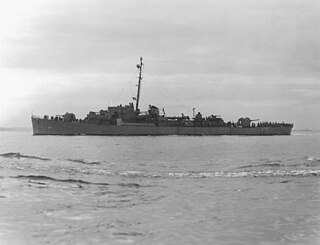
Destroyer escort (DE) was the United States Navy mid-20th-century classification for a 20-knot warship designed with the endurance necessary to escort mid-ocean convoys of merchant marine ships. The Royal Navy and Commonwealth forces identified such warships as frigates, and that classification was widely accepted when the United States redesignated destroyer escorts as frigates (FF) in 1975. From circa 1954 until 1975 new-build US Navy ships designated as destroyer escorts (DE) were called ocean escorts. Destroyer escorts and frigates were mass-produced for World War II as a less expensive antisubmarine warfare alternative to fleet destroyers. Similar types of warships in other navies of the time included the 46 diesel-engined Kaibōkan of the Imperial Japanese Navy., 10 Kriegsmarine escort ships of the F-class and the two Amiral Murgescu-class vessels of the Romanian Navy.
USS Cummings has been the name of more than one United States Navy ship, and may refer to:

USS Samuel B. Roberts (FFG-58) is one of the final ships in the United States Navy's Oliver Hazard Perry-class of guided missile frigates (FFG). Commissioned in 1986, the ship was severely damaged by an Iranian mine in 1988, leading U.S. forces to respond with Operation Praying Mantis. Repaired and returned to duty, the ship served until decommissioned in 2015.

USS Johnston (DD-557) was a Fletcher-class destroyer in the service of the United States Navy in World War II, the first Navy ship named after Lieutenant John V. Johnston. The ship is known for her action in the Battle off Samar. The small "tincan" destroyer, armed with torpedoes, and guns no larger than 5 inches (127 mm), led an attack by a handful of light ships which had inadvertently been left unprotected in the path of a Japanese fleet with battleships and cruisers. The actions of Johnston—sunk in the battle—and the lightly armed and lightly armored Escort Carrier Task Unit 77.4.3, of which she was a member, helped stop Admiral Kurita's Center Force from attacking the U.S. landing forces and inflicted greater damage on the Japanese attackers than they suffered. Johnston's wreck is the deepest surveyed shipwreck after having been rediscovered and identified in March 2021.

USS Samuel B. Roberts (DE-413) was a John C. Butler-class destroyer escort of the United States Navy that served during 1944.
Three ships of the United States Navy have been named USS Jacob Jones, in honor of Jacob Jones:

Ernest Edwin Evans was an officer of the United States Navy who posthumously received the Medal of Honor for his actions during the Battle off Samar in World War II.

The Evarts-class destroyer escorts were destroyer escorts launched in the United States in 1942–44. They served in World War II as convoy escorts and anti-submarine warfare ships. They were also known as the GMT or "short hull" DE class, with GMT standing for General Motors Tandem Diesel drive.
USS Stewart may refer to the following ships of the United States Navy:
Two ships of the United States Navy have been named USS Chase.

The John C. Butler class were destroyer escorts that originated during World War II. The lead ship was USS John C. Butler, commissioned on 31 March 1944. The class was also known as the WGT type from their Westinghouse geared turbine drive. Of the 293 ships originally planned, 206 were canceled in 1944 and a further four after being laid down; three were not completed until after the end of World War II.

The Cannon class was a class of destroyer escorts built by the United States primarily for antisubmarine warfare and convoy escort service during World War II. The lead ship, USS Cannon, was commissioned on 26 September 1943 at Wilmington, Delaware. Of the 116 ships ordered, 44 were cancelled and six were commissioned directly into the Free French Forces. Destroyer escorts were regular companions escorting vulnerable cargo ships.
USS Roberts may refer to more than one United States Navy ship:

USS Oberrender (DE-344) was a John C. Butler–class destroyer escort built for the United States Navy during World War II. She was named for Lieutenant Commander Thomas Olin Oberrender Jr., the engineering officer of the light cruiser USS Juneau, who was killed when that ship was torpedoed and sunk during the Naval Battle of Guadalcanal in 1942.

USS Samuel S. Miles (DE-183) was a Cannon-class destroyer escort built for the United States Navy during World War II. She served in the Pacific Ocean and provided escort service against submarine and air attack for Navy vessels and convoys. She returned home at war's end with eight battle stars to her credit.

USS Falgout (DER-324) was an Edsall-class destroyer escort built for the U.S. Navy during World War II. She served in the Atlantic Ocean and provided destroyer escort protection against submarine and air attack for Navy vessels and convoys. Post-war, she was borrowed by the U.S. Coast Guard and also served as a radar picket ship on the Distant Early Warning Line. She was reclassified DER-324 on 28 October 1954.
USS Williams has been the name of more than one United States Navy ship, and may refer to:
USS Keppler has been the name of more than one United States Navy ship, and may refer to:
USS Johnson may refer to various United States Navy ships:
HMS Garlies (K475) was a British Captain-class frigate of the Royal Navy in commission during World War II. Originally constructed as the United States Navy Evarts-class destroyer escort USS Fleming (DE-271), she served in the Royal Navy from 1943 to 1945 and in the U.S. Navy as USS Garlies (DE-271) from August to October 1945.
This page is based on this
Wikipedia article Text is available under the
CC BY-SA 4.0 license; additional terms may apply.
Images, videos and audio are available under their respective licenses.









